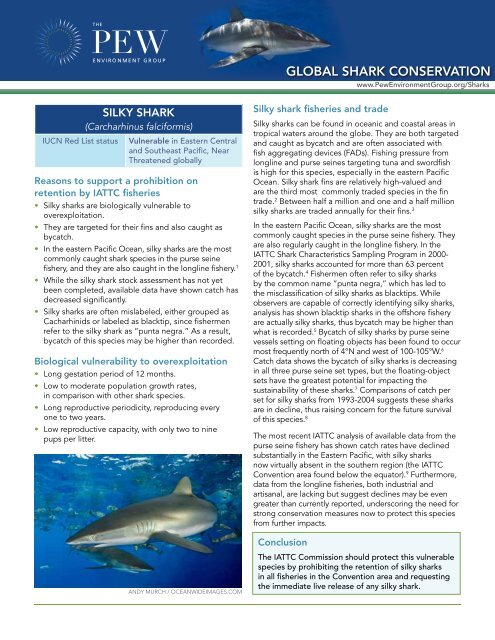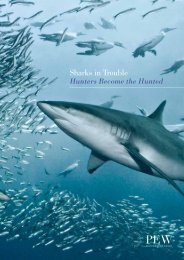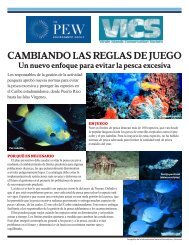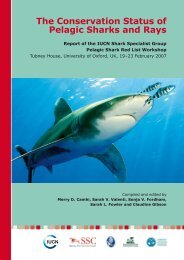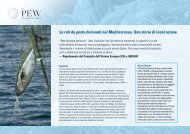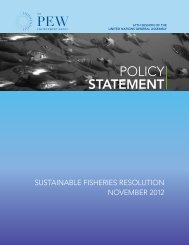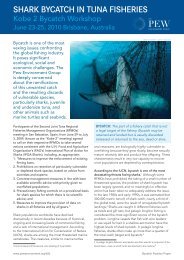You also want an ePaper? Increase the reach of your titles
YUMPU automatically turns print PDFs into web optimized ePapers that Google loves.
GLOBAL SHARK CONSERVATION<br />
www.PewEnvironmentGroup.org/<strong>Shark</strong>s<br />
IUCN Red List status<br />
SILKY SHARK<br />
(Carcharhinus falciformis)<br />
Vulnerable in Eastern Central<br />
and Southeast Pacific, Near<br />
Threatened globally<br />
Reasons to support a prohibition on<br />
retention by IATTC fisheries<br />
••<br />
<strong>Silky</strong> sharks are biologically vulnerable to<br />
overexploitation.<br />
••<br />
They are targeted for their fins and also caught as<br />
bycatch.<br />
••<br />
In the eastern Pacific Ocean, silky sharks are the most<br />
commonly caught shark species in the purse seine<br />
fishery, and they are also caught in the longline fishery. 1<br />
••<br />
While the silky shark stock assessment has not yet<br />
been completed, available data have shown catch has<br />
decreased significantly.<br />
••<br />
<strong>Silky</strong> sharks are often mislabeled, either grouped as<br />
Cacharhinids or labeled as blacktip, since fishermen<br />
refer to the silky shark as “punta negra.” As a result,<br />
bycatch of this species may be higher than recorded.<br />
Biological vulnerability to overexploitation<br />
••<br />
Long gestation period of 12 months.<br />
••<br />
Low to moderate population growth rates,<br />
in comparison with other shark species.<br />
••<br />
Long reproductive periodicity, reproducing every<br />
one to two years.<br />
••<br />
Low reproductive capacity, with only two to nine<br />
pups per litter.<br />
ANDY MURCH / OCEANWIDEIMAGES.COM<br />
<strong>Silky</strong> shark fisheries and trade<br />
<strong>Silky</strong> sharks can be found in oceanic and coastal areas in<br />
tropical waters around the globe. They are both targeted<br />
and caught as bycatch and are often associated with<br />
fish aggregating devices (FADs). Fishing pressure from<br />
longline and purse seines targeting tuna and swordfish<br />
is high for this species, especially in the eastern Pacific<br />
Ocean. <strong>Silky</strong> shark fins are relatively high-valued and<br />
are the third most commonly traded species in the fin<br />
trade. 2 Between half a million and one and a half million<br />
silky sharks are traded annually for their fins. 3<br />
In the eastern Pacific Ocean, silky sharks are the most<br />
commonly caught species in the purse seine fishery. They<br />
are also regularly caught in the longline fishery. In the<br />
IATTC <strong>Shark</strong> Characteristics Sampling Program in 2000-<br />
2001, silky sharks accounted for more than 63 percent<br />
of the bycatch. 4 Fishermen often refer to silky sharks<br />
by the common name “punta negra,” which has led to<br />
the misclassification of silky sharks as blacktips. While<br />
observers are capable of correctly identifying silky sharks,<br />
analysis has shown blacktip sharks in the offshore fishery<br />
are actually silky sharks, thus bycatch may be higher than<br />
what is recorded. 5 Bycatch of silky sharks by purse seine<br />
vessels setting on floating objects has been found to occur<br />
most frequently north of 4°N and west of 100-105°W. 6<br />
Catch data shows the bycatch of silky sharks is decreasing<br />
in all three purse seine set types, but the floating-object<br />
sets have the greatest potential for impacting the<br />
sustainability of these sharks. 7 Comparisons of catch per<br />
set for silky sharks from 1993-2004 suggests these sharks<br />
are in decline, thus raising concern for the future survival<br />
of this species. 8<br />
The most recent IATTC analysis of available data from the<br />
purse seine fishery has shown catch rates have declined<br />
substantially in the Eastern Pacific, with silky sharks<br />
now virtually absent in the southern region (the IATTC<br />
Convention area found below the equator). 9 Furthermore,<br />
data from the longline fisheries, both industrial and<br />
artisanal, are lacking but suggest declines may be even<br />
greater than currently reported, underscoring the need for<br />
strong conservation measures now to protect this species<br />
from further impacts.<br />
Conclusion<br />
The IATTC Commission should protect this vulnerable<br />
species by prohibiting the retention of silky sharks<br />
in all fisheries in the Convention area and requesting<br />
the immediate live release of any silky shark.
References<br />
1. Inter-American Tropical Tuna Commission, “Fishery Status Report 8,”<br />
La Jolla, CA, 2010. <br />
2. S. Clarke, J.E. Magnusson, D.L. Abercrombie, M. McAllister and M.S.<br />
Shivji, “Identification of shark species composition and proportion in<br />
the Hong Kong shark fin market using molecular genetics and trade<br />
records,” Conservation Biology 20: 201-211 (2006).<br />
3. R., Bonfil, A. Amorim, C. Anderson, R. Arauz, J. Baum, S.C. Clarke,<br />
R.T. Graham, M. Gonzalez, M. Jolón, P.M. Kyne, P. Mancini, F.<br />
Márquez, C. Ruíz, and W. Smith. 2007. Carcharhinus falciformis. In:<br />
IUCN 2010. IUCN Red List of Threatened Species. Version 2010.4.<br />
Downloaded on 28 April 2011.<br />
4. M. Román-Verdesoto and M. Orozco-Zöller,“Bycatches of sharks in<br />
the tuna purse-seine fishery of the eastern Pacific Ocean reported<br />
by observers of the Inter-American Tropical Tuna Commission, 1993-<br />
2004,” Inter-American Tropical Tuna Commission Data Report 11, La<br />
Jolla, CA, 2005. <br />
5. M. Román-Verdesoto and M. Orozco-Zöller, “Bycatches of sharks in<br />
the tuna purse-seine fishery of the eastern Pacific Ocean reported<br />
by observers of the Inter-American Tropical Tuna Commission, 1993-<br />
2004,” Inter-American Tropical Tuna Commission Data Report 11, La<br />
Jolla, CA, 2005. <br />
6. Inter-American Tropical Tuna Commission, “Fishery Status Report 8,”<br />
La Jolla, CA, 2010. <br />
7. Inter-American Tropical Tuna Commission, “Fishery Status Report 8,”<br />
La Jolla, CA, 2010. <br />
8. M. Román-Verdesoto and M. Orozco-Zöller, “Bycatches of sharks in<br />
the tuna purse-seine fishery of the eastern Pacific Ocean reported<br />
by observers of the Inter-American Tropical Tuna Commission, 1993-<br />
2004,” Inter-American Tropical Tuna Commission Data Report 11, La<br />
Jolla, CA, 2005. <br />
9. A. Aires-da-Silva, “Progress report on the EPO silky shark stock<br />
assessment,” Inter-American Tropical Tuna Commission, 3rd Meeting<br />
of the Scientific Advisory Committee, La Jolla, CA, May 15-18, 2012.<br />
<br />
Contact: KerriLynn Miller I Global <strong>Shark</strong> Conservation Campaign Associate I +1 202 540 6481 I klmiller@pewtrusts.org


